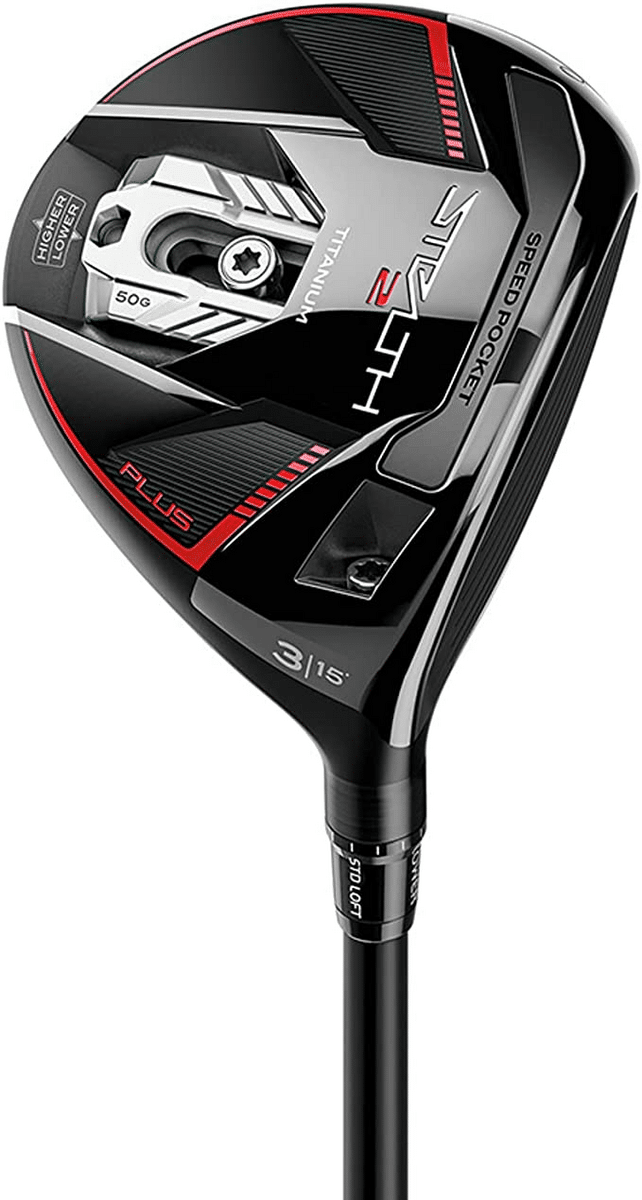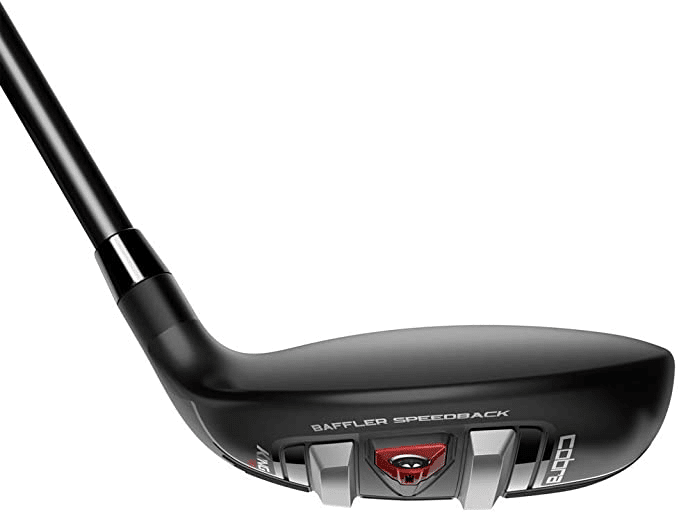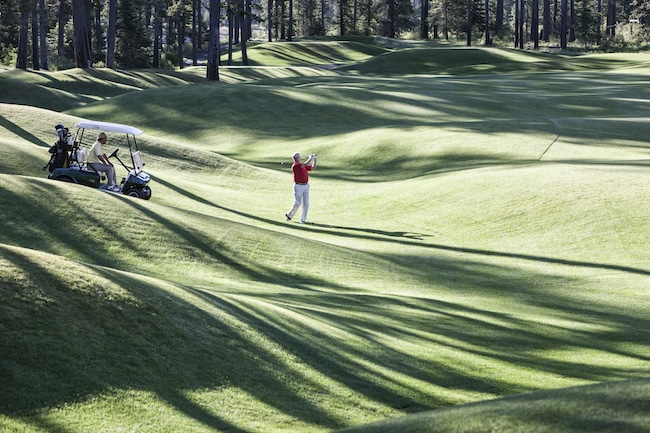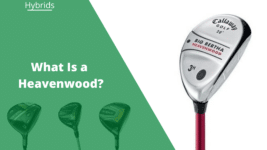Are you wondering whether a fairway wood vs. hybrid is better for your golf game? Trust us; you’re not alone! Many golfers grapple with this dilemma as they try to fine-tune their club selection.
In this article, you’ll learn the differences between fairway woods and hybrids, explore their unique features, and guide you in determining the perfect club combo tailored to your specific needs.
Fairway Wood vs. Hybrid Distance Chart
| Club | Slow Swing Speed (yds) | Medium Swing Speed (yds) | Fast Swing Speed (yds) |
| 3 Hybrid | 163 | 189 | 205 |
| 4 Hybrid | 154 | 179 | 194 |
| 5 Hybrid | 145 | 168 | 183 |
| 6 Hybrid | 136 | 158 | 171 |
| 7 Hybrid | 127 | 147 | 160 |
| 3 Wood | 170 | 210 | 225 |
| 5 Wood | 150 | 195 | 205 |
Fairway Woods: Benefits, Specs, & Ideal Uses

Essential clubs in a golfer’s bag, fairway woods are designed for long-distance shots from the fairway or off the tee.
Characteristics Of Fairway Woods
Used for long shots from the fairway or off the tee where distance and accuracy are crucial, fairway woods feature a large, rounded clubhead, a shallow face, and a long shaft to maximize distance and forgiveness.
Clubhead Size And Shape
The clubhead size of fairway woods is larger than that of hybrids and irons, providing increased forgiveness and stability during impact. The round and shallow face design promotes a high launch angle, making it easier to get the ball airborne and achieve the desired distance.
Loft Angle
Fairway woods have lower loft angles compared to hybrids. A 3-wood, for example, typically has a loft angle of 15-18 degrees, while a 5-wood ranges from 18-21 degrees. These lower loft angles help create a lower trajectory and more penetrating ball flight, allowing for increased distance.
However, between 5 wood vs. hybrid 3, the latter is typically easier to hit from the rough due to its smaller size and lower center of gravity.
Center Of Gravity
The center of gravity in a fairway wood is positioned farther back and lower than wood hybrid and iron. Higher launch angles and increased forgiveness on off-center hits are possible due to hybrids’ lower center of gravity.
Distance
Generating significant distance, fairway woods are a must-have for golfers aiming to cover extended stretches on the course. Take a 3-wood, for example; it can deliver shots spanning 210 to 240 yards for your average golfer, while a 5-wood can reach distances between 190 and 215 yards.
Ideal Situations For Using Fairway Woods
Fairway woods are best suited for long shots from the tee or fairway, where their distance capabilities and forgiveness can provide a significant advantage.
They are also useful for second shots on par-5 holes, where reaching the green in two may be possible with a well-executed fairway wood shot.
Popular Fairway Wood Models
Some well-regarded fairway wood models include the TaylorMade Stealth 2, TaylorMade SIM2, Callaway Mavrik, and Ping G425. These clubs have gained popularity among golfers for their performance, forgiveness, and adaptability.
Our Favorite Fairway Wood:
Read more: The Best Fairway Woods for High Handicappers
Hybrids: Benefits, Specs, & Ideal Uses

Hybrid clubs, often referred to as rescue clubs or utility clubs, are designed to combine the best features of both fairway woods and long irons.
They offer the distance and forgiveness of a fairway wood while maintaining the ease of use and playability of iron, making them a popular choice for golfers of all skill levels. If you’re looking for a full-scale article on what are hybrids, we’ve got them all here at GolfSpan as well.
Features Of Hybrid Clubs
Hybrids are characterized by their compact clubhead, shorter shaft, and higher loft angles than fairway woods. These features make hybrids easier to hit from various lies, including the rough and tight lies, and provide a higher ball flight with a softer landing.
Clubhead Size And Shape
Hybrids have a smaller clubhead than fairway woods, which can be easier to hit for some golfers. The compact design helps players make better contact with the ball, especially from challenging lies like the rough or tight fairways.
Loft Angle
Hybrids typically have a higher loft angle than fairway woods. A 3-hybrid, for example, generally has a loft angle of 19-21 degrees, while a 4-hybrid ranges from 22-24 degrees. The higher loft angles contribute to a higher ball flight with a softer landing, making hybrids a popular choice for approach shots into greens.
Center Of Gravity
Hybrids have a lower center of gravity than fairway woods, which helps golfers easily get the ball airborne. Combined with higher loft angles, they provide more consistent and forgiving shots from a range of lies.
Distance
Although hybrids might not match fairway woods in distance, they still pack a punch. A 3-hybrid, for example, typically delivers shots between 180-210 yards for average players, while a 4-hybrid ranges from 170-200 yards.
The versatility and distance offered by hybrids make them a valuable addition to any golfer’s arsenal.
Ideal Situations For Using Hybrids
Hybrids are well-suited for various situations on the golf course, including shots from the rough, tight lies, and even fairway bunkers. They can also be used for approach shots to greens, where their higher ball flight and softer landing can help golfers hold the green more effectively.
Additionally, hybrids can be used off the tee on shorter par-4 holes, where accuracy is more critical than the maximum distance.
Popular Hybrid Models
Some popular hybrid models include the Cobra F9 Speedback, Callaway Apex, and TaylorMade SIM2 Max. These clubs have earned praise from golfers for their performance, ease of use, and versatility on the course.
Our Favorite Hybrid:
If you’re a high handicapper looking to improve your game, we have a helpful guide on the best hybrid golf clubs to consider, including options from major brands like TaylorMade and Callaway.
Comparing Fairway Wood vs. Hybrid

Although fairway woods generally produce greater distances due to their lower loft angles and longer shafts, hybrids can offer more forgiveness and versatility, making them a valuable addition to a golfer’s bag.
Between 3 wood vs. 3 hybrid, the former typically hit the ball farther but can be more difficult to hit, while a 3 hybrid is more forgiving and easier to hit but may not hit the ball as far.
The higher launch angles and lower center of gravity found in hybrids facilitate easier ball launch, while their higher spin rates result in a higher, softer ball flight with less roll. This can be beneficial when selecting the right club for specific situations on the course, such as approach shots into greens or recovery shots from challenging lies.
Additionally, golfers should consider the gap between clubs to ensure they have a suitable club for each specific yardage they encounter on the course.
Proper gapping can be achieved by experimenting with different club combinations and considering the potential distance gaps and overlaps when comparing fairway woods and hybrids.
Forgiveness And Ease Of Use
Forgiveness: Fairway woods offer more forgiveness than long irons due to their larger clubhead size and lower center of gravity.
However, hybrids can provide even greater forgiveness than fairway woods. Their compact clubhead design and lower center of gravity make achieving solid contact and consistent shots easier, particularly from challenging lies.
Ease of use: Hybrids are generally considered easier to hit than fairway woods and long irons, particularly for golfers with slower swing speeds or less consistent ball-striking abilities.
Hybrids’ higher loft angles and lower center of gravity facilitate getting the ball airborne more easily and provide a more consistent performance across various course conditions.
Shot Types Best Suited For Each Club
Long shots from the tee or fairway: Fairway woods are typically the preferred choice for long shots from the tee or fairway, where distance is a priority. Their lower loft angles and longer shafts enable golfers to generate greater distance and a more penetrating ball flight.
Approach shots into greens: Hybrids are often favored for approach shots into greens, particularly from difficult lies, such as the rough or tight fairways. Their higher loft angles, higher spin rates, and softer landing characteristics make them more suitable for holding greens and achieving greater shot-stopping control.
Recovery shots from challenging lies: Hybrids excel when golfers must recover from challenging lies, such as heavy rough, fairway bunkers, or even tight lies with little grass beneath the ball.
Their compact clubhead design and lower center of gravity enable golfers to make better contact and achieve a more consistent, high-launching shot.
What Woods And Hybrids Should I Carry?

Choosing the right combination of woods and hybrids to carry in your golf bag can be a complex process, as it requires understanding your game, swing characteristics, and the golf courses you frequently play.
Assessing Your Strengths And Weaknesses
Begin by evaluating your strengths and weaknesses on the golf course. For example, if you struggle with long iron shots, consider replacing them with easier-to-hit hybrids.
Conversely, if you excel in hitting fairway woods but find hybrids less reliable, focus on carrying more fairway woods.
Analyzing Your Typical Golf Course Conditions
If your go-to course features tight fairways and small greens, hybrids might be better, offering greater control and accuracy. Conversely, if wide fairways and large greens are the norms, fairway woods can help you achieve the necessary distance to reach the greens with fewer strokes.
Evaluating Shot Trajectories And Ball Flights
Consider the shot trajectories and ball flights you typically produce with your current set of clubs. If you struggle to achieve the desired ball flight with fairway woods, try testing hybrids to see if they provide the trajectory and control you seek.
Similarly, fairway woods might be better if you require more distance and penetrating ball flight.
Conducting On-Course Testing And Experimentation
Spend time on the driving range and the golf course experimenting with various club combinations to see how they perform in different situations, such as off the tee, from the fairway, and on the rough.
Balancing Distance Gaps And Club Versatility
Ensure that you maintain proper distance gaps between the clubs in your bag and avoid carrying clubs with overlapping distances. To achieve a well-rounded setup, consider carrying a mix of fairway woods and hybrids that offer both distance and versatility, allowing you to tackle various on-course scenarios.
By considering these factors and implementing the tips provided, you can make more informed decisions about the right combination of woods and hybrids to carry in your golf bag.
Ultimately, the goal is to create a club setup that complements your game, allowing you to perform at your best and enjoy the sport to the fullest.
How To Select A Club Based On Course Conditions
Regarding club selection, course conditions play a crucial role. To optimize your performance, it’s vital to adjust your choices based on each course’s challenges.
- Look closely at the course layout, factoring in hole lengths, hazards, and the state of fairways and greens.
- Fine-tune your club selection to tackle specific challenges like narrow fairways, lengthy water carries, or greens at higher elevations.
- Stay adaptable during your round as conditions shift, such as rising wind levels or altered pin placements.
Tips For Improving Your Game With Hybrid vs. Wood
To get the most out of your fairway woods and hybrids, it’s essential to focus on proper club fitting, swing technique, and course management strategies.
Proper Club Fitting
Having your clubs properly fitted to your swing can significantly impact your performance. A professional club fitting will ensure that your fairway woods and hybrids have the correct shaft flex, length, and lie angle for your swing, helping you achieve optimal results on the course.
Swing Technique
Developing a solid swing technique is crucial to maximize your success with fairway woods and hybrids. Working with a teaching professional can help you identify and correct any swing flaws, leading to better contact and more consistent results.
Course Management Strategies
Effective course management is vital to lowering your scores and getting the most out of your fairway woods and hybrids. Consider factors such as wind, hazards, and pin positions when planning your shots, and be prepared to adjust your strategy as conditions change during your round.
FAQs
Do Hybrid Clubs Replace Fairway Woods?
No, Hybrid clubs do not necessarily replace fairway woods, but they can be a suitable alternative for some golfers. Hybrids offer more versatility and forgiveness, especially in challenging lies.
However, fairway woods provide greater distance and a more penetrating ball flight. The choice depends on individual preferences, skill level, and specific on-course situations.
What’s Better Off The Tee?
Fairway woods generally offer more distance and lower ball flight, while hybrids provide a higher launch angle and more control. Golfers should consider factors such as course layout, personal strengths, and tee-shot strategy. Generally, fairway woods and hybrids can be effective off the tee, but the choice depends on the golfer’s needs.
What’s Better From The Fairway?
The choice between fairway woods and hybrids from the fairway depends on factors like distance to the green, lie, and shot requirements. Fairway woods are typically better for longer shots, while hybrids can offer more control and a higher, softer ball flight. Golfers should assess each situation and choose the best club that fits their needs and shot objectives.
Conclusion
To summarize everything, you must understand the key differences between fairway woods and hybrids. This is especially true if you’re looking to optimize your club selection and elevate performance on the course.
By considering factors such as clubhead size and shape, loft angle, center of gravity, and distance, you can determine the best mix of clubs that cater to your specific strengths and weaknesses.
Don’t be afraid to experiment with different combinations of fairway woods and hybrids, as the right club setup can significantly impact your game. Ultimately, the choice between fairway wood vs hybrid will depend on your skill level and the unique challenges presented by the courses you play.
Clint is PGA-certified and was a Head Teaching Professional at one of Toronto's busiest golf academies. He was also featured on Canada's National Golf TV program, "Score Golf Canada," twice. He graduated with a degree in Golf Management from the College of the Desert in California and studied under Callaway's co-founder, Tony Manzoni. He has a handicap index of 6.2 and spends the winters near Oaxaca, Mexico, where he plays twice a month at the Club de Golf Vista Hermosa. He's written over 100 articles at GolfSpan since 2021. You can connect with Clint at LinkedIn, FB, his website, or Clintcpga@gmail.com.







